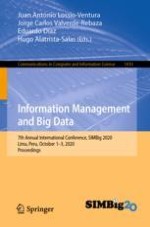2021 | Book
Information Management and Big Data
7th Annual International Conference, SIMBig 2020, Lima, Peru, October 1–3, 2020, Proceedings
Editors: Juan Antonio Lossio-Ventura, Jorge Carlos Valverde-Rebaza, Eduardo Díaz, Hugo Alatrista-Salas
Publisher: Springer International Publishing
Book Series : Communications in Computer and Information Science
